ON the edge of the desert, the frontier town of Menindee is brimming with history. The banks of the Darling River, Menindee Lakes and Kinchega National Park weave a colourful and deep tapestry. Thousands of years of Indigenous and early settler history, including the expedition of Burke and Wills, has whet the appetite for tourists today. But with a whirlwind of negative press following a series of fish kills, the community is fighting to find its feet. Some of this coverage has brought much-needed government funding and curious travellers – but many locals and farmers feel cheated by the government’s management of water. Hear their stories >
Tourism operators fight to save Menindee
Country girl at heart and Menindee local, Deb Newitt lives and works with her partner Rob Gregory at Copi Hollow – a paradise for water-lovers, skiers and fishermen that joins the Menindee Lakes system. “It’s like an oasis here,” says Deb, who runs Copi Hollow Caravan Park and River Lady boat tours with Rob, attracting a stream of tourists and locals to enjoy their spot 13km north of Menindee.
We arrive mid-morning and there’s 50 tourists, mostly retirees from Sydney, eagerly awaiting their lake tour. The shores are a picturesque scene lined with weeping willows and green grass, that by circumstance has become the only place for tourists to take boat rides. Lake Menindee is bone dry,
down to less than 1% of its capacity.
“When I first came here two years ago, we’d run three cruises a day, now we’d be lucky to do two cruises a week – so if the water drops we won’t be able to operate our cruises,” Deb says.
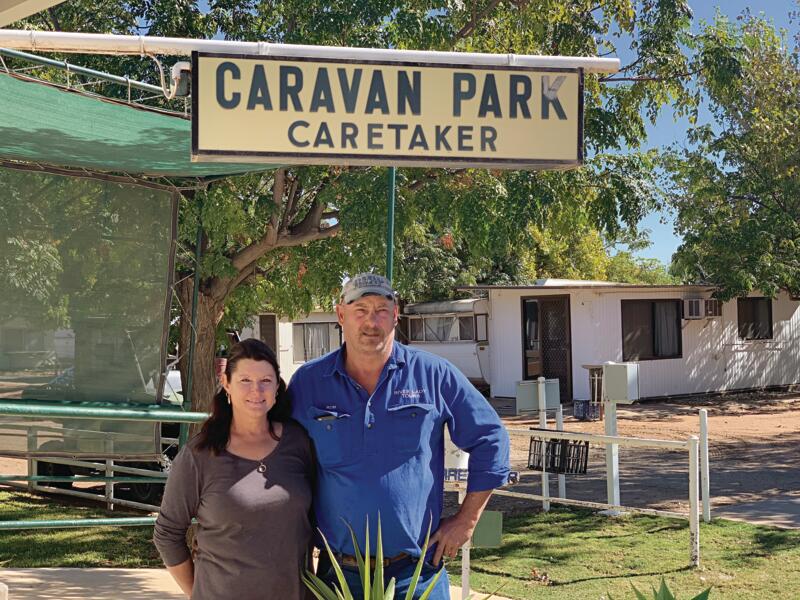 Deb Newitt and Rob Gregory at the Copi Hollow Caravan Park, which offers 22 caravan sites and four cabins just north of Menindee.
Deb Newitt and Rob Gregory at the Copi Hollow Caravan Park, which offers 22 caravan sites and four cabins just north of Menindee.
As well as running Copi Hollow, Rob is one of only two electricians in town and president of the Menindee Regional Tourist Association – so fighting for this community is his top priority. “It’s a wonderful place at Menindee but it’s just so hard to move forward without water,” Rob says.
“I was really lucky in 2016 [when he bought the business] – by January 2017 the lakes were full here, and then due to legislation and circumstances out of our control, they were emptied.”
Rob compares the aftermath of the headline-hitting Menindee fish kills last summer to the bleaching of the coral on the Great Barrier Reef. “There’s still plenty to see up at the Reef, but people aren’t turning up because of that white noise factor, that’s really pushed people away,” says Rob.
He is proud to show visitors the beauty of this place, which is very much alive. “Menindee is known for its birds, there’s 240 species here.”
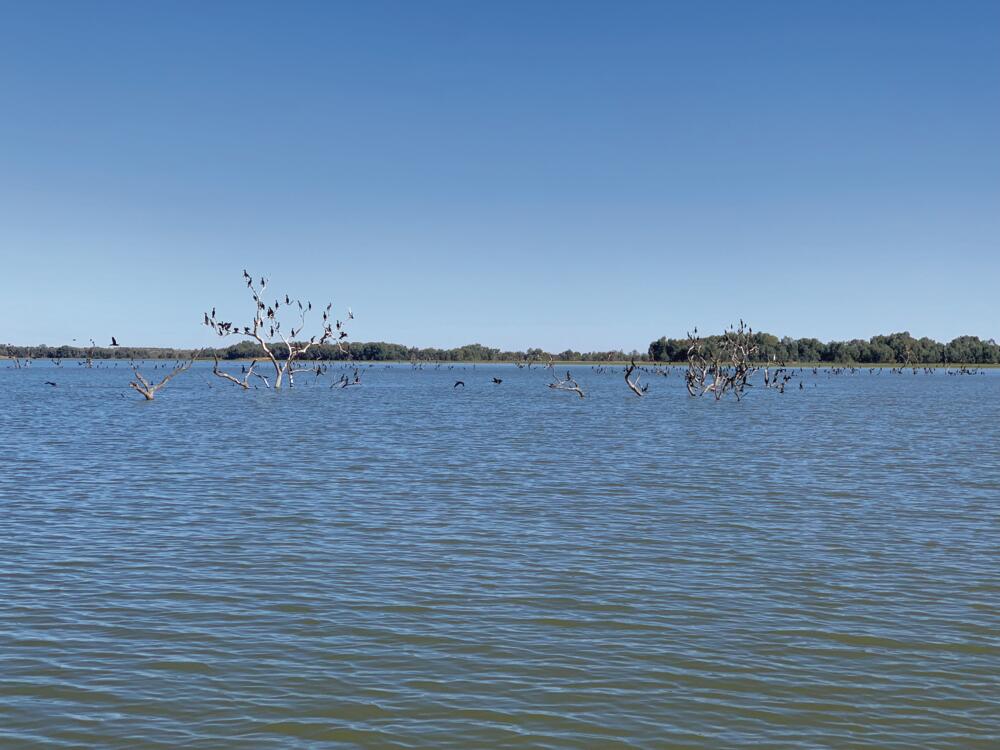 Birdlife at Lake Copi Hollow, while on the River Lady Tour.
Birdlife at Lake Copi Hollow, while on the River Lady Tour.
No fish died in Lake Copi Hollow during the fish kills, Rob explains to his boat passengers, so bird life is still quite abundant now with flocks of pelicans and egrets flying by – cameras at the ready.
The artificially-created lake, which connects Lakes Pamamaroo and Menindee via a channel, is 43% full right now, Rob says. It provided Broken Hill and Menindee with water, one of the few sources, between December 2018 and March 2019, when the Darling River was ravaged with blue-green algae and before the Wentworth-Broken Hill pipeline became operational.
SPECIAL FEATURE > Far West graziers thrive despite water crisis
“This is just a pond in the middle of nowhere, so what’s here is here and if this drought goes further, the water is not going to last forever,” Rob says.
The fish kills have created a domino effect in the community. “It’s peoples’ day-to-day lives, it’s our drinking water, showering water and for some of us it’s our livelihoods that are suffering,” Deb says.
“The fish kills have knocked the town for six, it’s knocked them hard.” - Deb Newitt
“The town’s economy has suffered, along with their business with noticeably less tourists.”
But the community spirit is still strong. In a bid to help raise much-needed funds and awareness for their town, Deb embarked on a charity ride in April with her two horses, Nicky and Axel, covering 124km from Pooncarie to Menindee.
The ride took several days, with regular social media updates, and ended with a celebratory fundraiser at Menindee’s Maidens Hotel, raising $3,600 for the tourist association to help pay for refurbishments at the Menindee visitor centre.
“Even if I raised $200 it would be $200 more than what we have,” Deb says. “It was awesome, I absolutely loved the ride and Rob was there for support [with the horse float and camper].”
Deb and Rob hope initiatives like this, along with recent government funding led by the tourist association, will help attract more visitors. They’re been pushing to get the road sealed between Pooncarie and Menindee for some time, Rob says. “Once that’s done it will open us up to tourism – it’s a critical link that’s very, very important to us.”
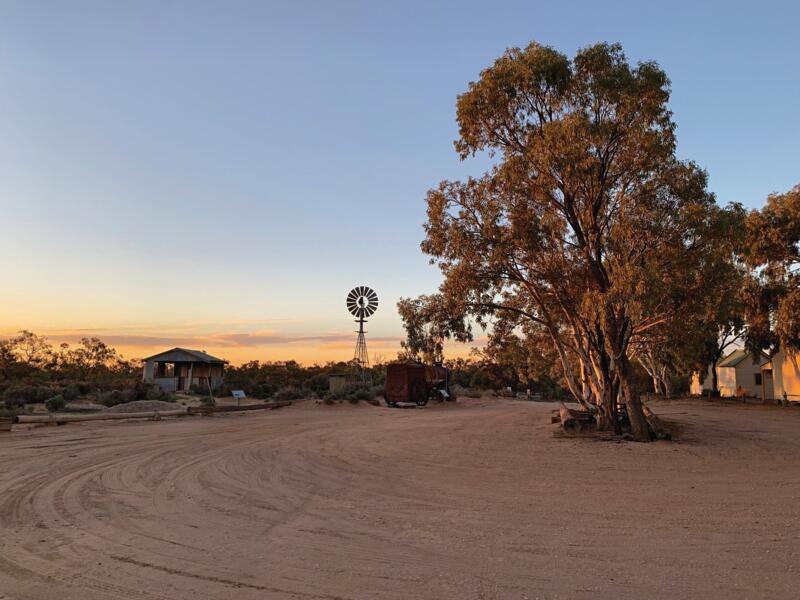 Kinchega National Park, a hot spot for tourists when visiting the Menindee region.
Kinchega National Park, a hot spot for tourists when visiting the Menindee region.
Deb adds, “It’s a great little town with lots of history. We’d like the media to give a positive spiel, not just negative white noise. Focus on what we do have, not what we don’t. Menindee wasn’t on the map before,” she acknowledges. “It is now, so if you want to know what it’s like, come and see for yourself.”
Drought-tolerant fruit creates fresh business opportunity
The Menindee post office is a one- stop-shop with a bank and a gift shop overflowing with supplies, from toasters to iPads. “You can buy anything at the post office,” says its manager Dave Baker, also a small-time farmer and Menindee tourist association committee member.
.jpg) Dave Baker, Post office manager and small fruit farmer.
Dave Baker, Post office manager and small fruit farmer.
The day The Farmer visited, Dave had a special desert lime-infused gin from Mildura that’s been awaiting collection for some weeks now – he jokes he might have to crack it open soon. He’s developed a taste for desert fruits and for a change of pace, having never farmed before, bought seven hectares of land with his wife Jane in 2013 just 2km out of Menindee. He’s planted 100 trees of the hardy Chinese fruit, jujube, which he’s eager to expand.
“I was going to plant desert limes and fruit trees but I found these jujubes – they’re drought-tolerant, the Chinese are interested in them and there’s only a couple of places in Australia growing them,” Dave says.
Related articles of diversification:
Third generation farmers make a switch
Livestock to hay production: Tamworth farmer diversifies
Merino sheep to rangeland goats reaping rewards
From berries to Christmas trees
The red-coloured fruit, known as a Chinese date, has many health benefits, can be consumed fresh, cooked, dried or candied and tastes like an apple. The small deciduous tree bears fruit in its first year, he says but quality fruit takes four-to-five years, yielding up to 20-40kg per tree on average and fetching $30-$45/kg for dried and $15-$25/kg for fresh.
He’s lining up contracts to sell fresh produce to
Sydney Markets and dried fruit through a Facebook page and the post office. One day he hopes to export to China where the fruit is highly sought-after, particularly for Chinese New Year.
Dave harvested his first crop in March to April this year, averaging 5kg per tree, and plans to hire pickers in the future to make the most of this growing business. “It’s been pretty easy to set up, purchasing the trees was the hardest part.”
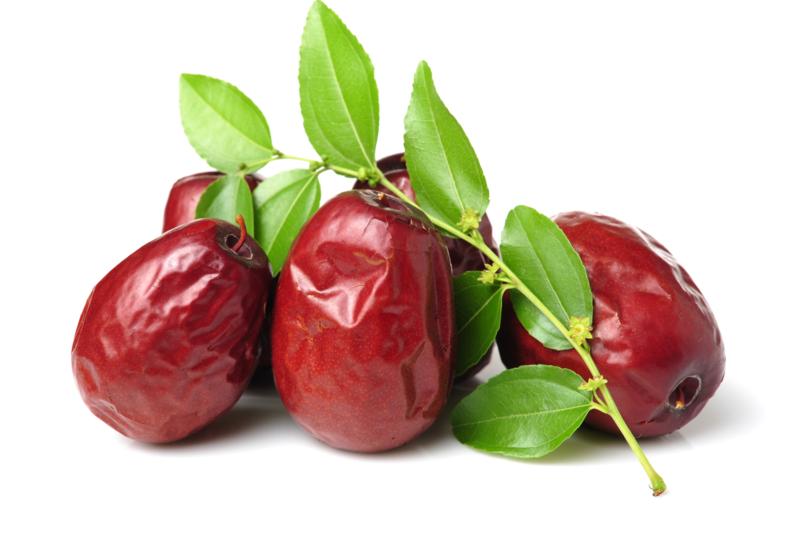 Jujube, a hardy Chinese fruit that grows well in the increasingly dry conditions.
Jujube, a hardy Chinese fruit that grows well in the increasingly dry conditions.
His neighbour has been trialling new crops too, like chilli, capsicums and dew melons, that are working well. Jujubes have grown in desert environments for over 4,000 years, Dave says. “At the time of planting, the water was very saline, and they survived so they can put up with a lot of salt water.” That’s a perfect fit for the increasingly dry conditions.
They’ve had a bit of rain so it’s okay, he says but they need to fill the river and the lakes.
“They empty the lakes too quick and then there’s nothing left, there’s no rain coming, so they’re going to be dry again.” - Dave Baker
“So instead of letting it go in a year, they should be letting it go in three or four years like they did in the 1970s, 1980s and 1990s. We never used to see the lakes dry – or very rarely.”
Dave grew up in this district and has seen the lakes in their former glory. He lived at Menindee Lakes Caravan Park as a little fella for five years and later owned a holiday house at Sunset Strip for 13 years, the happening lakeside village of Menindee, now sadly derelict.
“We had sail clubs, boat clubs, golf clubs – it was very social. Even though the community has dropped off, from 1,000 to 550, people are still fighting.”
_preview.jpg) The Menindee Lakes community, Sunset Strip – bears a desolate horizon, taken in mid-May.
The Menindee Lakes community, Sunset Strip – bears a desolate horizon, taken in mid-May.
The tourist committee has done a lot of great things in the past year, he says to bring life back to the town. “But it’s hard because the [Central Darling] Shire is in administration and has been for five years – so it’s hard to get funding and resources, like helping to green the town up a bit.”
Darling River citrus farmer at wits end with water
Alan Whyte has built a profitable citrus business on the banks of the lower Darling River at Jamesville Station, south of Menindee, where his family has farmed in the area since the 1930s. He’s worked hard to secure valuable export contracts, with 50ha of mixed varieties including his highly sought-after seedless mandarin, to places like China worth $1.5million per year.
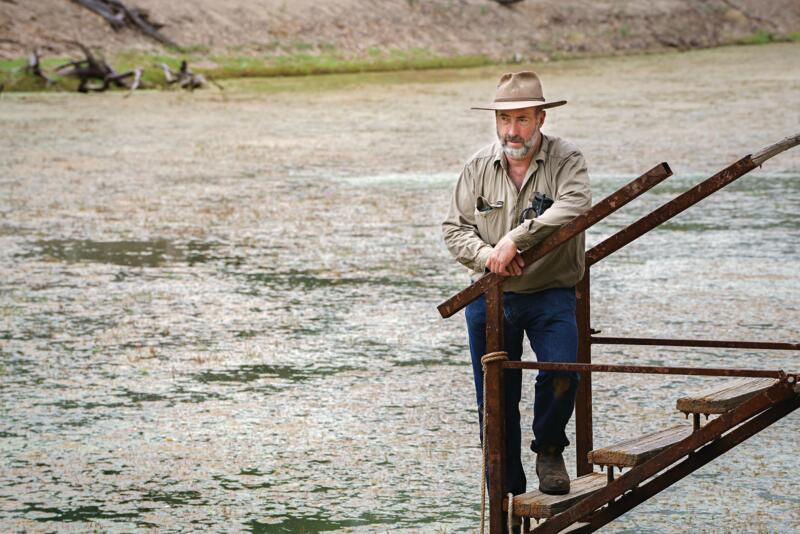 Citrus grower and NSW Farmers' member Alan Whyte by the lower Darling River on his property, when the water was higher. Credit: Sunraysia Daily.
Citrus grower and NSW Farmers' member Alan Whyte by the lower Darling River on his property, when the water was higher. Credit: Sunraysia Daily.
But today he faces a water crisis that “could be the end of the business”. “The reality is with the water we’ve got now we can probably get the crop off the trees,” Alan says. But to ensure there’s enough water for picking later varieties in September or October, he’s been forced to turn the irrigation valves off and abandon the trees once the crop is picked.
The mix of trees including oranges, mandarins, apples and red flesh grapefruit won’t use much water for the next couple of months, he says, but if there’s warmer weather and no flows in the Darling River it could all turn south.
“The citrus game is strong – and life is good apart from water.” - Alan Whyte
In the past few years Alan has had to remove patches of his citrus crops due to water. The problem is coming to a head as the Darling River faces its fourth cease-to-flow water event since 2003. Sadly he’s come to realise, with five other farming families, “permanent plantings are no longer viable on the lower Darling”. He puts this down to gross mismanagement of water sharing and disregard for a ‘whole-of-river’ approach that was put forward in the Lower Darling Horticulture Group’s submission to the Murray-Darling Basin Royal Commission in 2018. Alan spoke as a witness and as a member of the group.
“If we’re ever going to make any progress on the Darling River, we are going to have to run it on a whole-of-river basis. It mustn’t be run top down, which is what’s happening now. Top down means, if you’re at the bottom, life is not good.”
Their plan to remove permanent plantings from the lower Darling is policy-driven, he explains. It involves the transfer of high-security licences, loss of value to properties and significant removal costs, and it’s still under review or is yet to be actioned.
“We’re not proposing to be sacrificial lambs and we should not be expected to be, but we are six families versus the northern irrigation industry.”
Four temporary clay block banks are holding up the last of the water from the Menindee Lakes and one is at Jamesville Station, but it’s only got 700 to 800 megalitres left in it. “If the blocked banks weren’t there, everything would be dead already. They’re a symptom of a problem; they’re not a cure.”
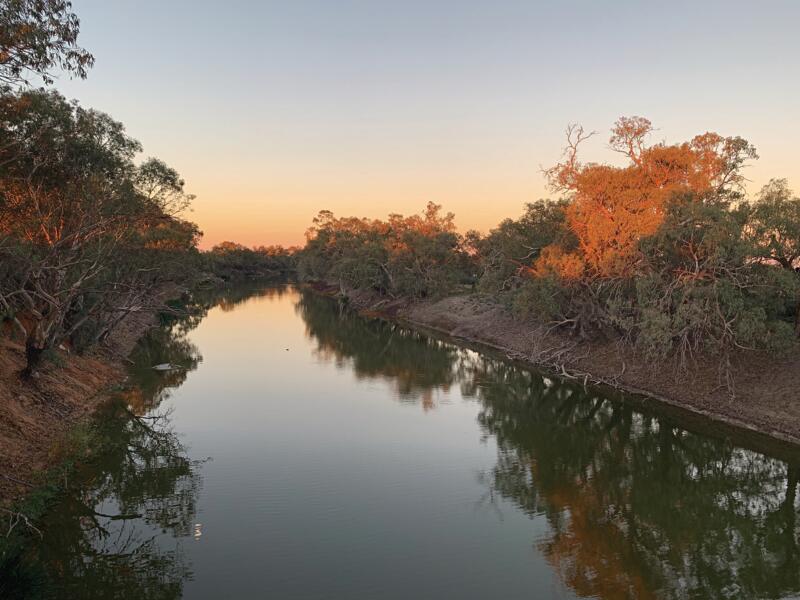 The banks of the Darling River, in the town of Menindee.
The banks of the Darling River, in the town of Menindee.
The banks are designed to pool water from the Darling and retain it for longer due to depth, but they’re nearing their tenure as water becomes increasingly “mucky and highly saline”.
Alan must inject concentrated sulphuric acid (up to 2,000-3,000 litres per week in summer) through irrigation lines to bring the pH down so it’s tolerable for his crops, at great expense. “It’s not ideal, but it’s our only option. We have the lowest reliability of water – that’s the policy that has done that, not the drought.”
He has a clear message. “Make getting fresh water to communities on the lower Darling more important than a supplementary irrigation licence.”
“It is literally true that under current rules the lowest priority irrigation licence up in northern NSW is a higher priority for access to water than fresh water to us.” - Alan Whyte
RELATED ARTICLES:
Who’s getting all the water?
Horticultural growers at wits’ end
Drought survey: How farmers are faring
How can we preserve our Great Artesian Basin?
Birdlife photographer fights to save Menindee Lakes
Geoff Looney in Menindee, Western NSW.
Geoff Looney is a well-known character of Menindee, a keen fisherman and birdlife photographer. We meet at Menindee post office, where he’s just dropped off some prints to sell.
The retired local has lived in town for 43 years, was president of the tourist association for five years and operated fishing and bird-watching tours between 1993 and 2016. “I had to give it away because I had no water to put the boat in. I was taking 400 people out each year and that was just gone,” Geoff says.
He’s deeply passionate about the Menindee region and its beauty.
“My life has been mostly about promoting the area, and it makes you very upset to think in these times we’ve been forgotten.” - Geoff Looney
“Our water has been drained, our fish have died, our beautiful lake system has been decommissioned virtually.”
“I’ve seen it in really good times – it’s such a great area because of the fish nursery that’s here, but you have got to have the environmental flows to keep it going. The Menindee Lakes is something that should be protected – it’s a disaster. This all came about with the extended allocations of water up north. You could virtually say the dams that were built up north are now taking over the lakes and you can’t have both.”
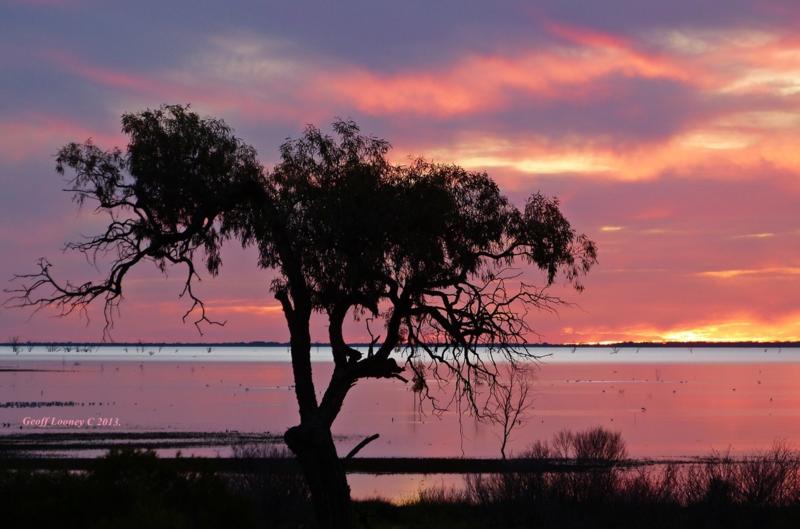 Lake Menindee is currently bone dry. Geoff Looney captured a beautiful sunset at Menindee Lake in 2013. Copyright: Menindee NSW Outback Photography.
Lake Menindee is currently bone dry. Geoff Looney captured a beautiful sunset at Menindee Lake in 2013. Copyright: Menindee NSW Outback Photography.
He tells us to check out his Facebook page,
Menindee NSW Outback Photography. “It’s going amazing, reaching 125,000 people in the week of the fish kill. It’s helped other places, to see what’s actually happened here – it’s disastrous.”
The people that really matter to the country, have never ever come to have a look, he says. “You know it’s out of sight, out of mind – there’s human beings out here and we care. Having to bring water into a place like Menindee is an absolute disgrace.”
Young farmer and environmentalist raises concern for climate
Young farmer, Anika Molesworth helps her family run the South African Dorper breed at Rupee Station near Broken Hill. Photograph supplied.
Living on the Darling River with her family at Rupee Station near Broken Hill, Anika Molesworth says: “Water is the building block of the farm – it’s becoming extremely scarce and increasingly competitive out here. When we purchased the farm in 2000 we dived head-first into the Millennium drought. This is what really sparked my interest – ‘How do you manage a farming property in this climate?’”
They run 800-1,000 Dorper sheep in a good season over 4,000 hectares and have gradually de-stocked since February to 40-to-50 sheep. “We’ve only received 3mm of rain in the last two-to-three months and last summer was such a scorcher with three weeks of over 40°C. Dams dried up and vegetation disappeared.” As someone who wants to take on the family farm one day, she says, how do I best prepare myself?
It was a harsh introduction into farming coming from Melbourne at 12 years old. But Anika later worked as a jillaroo in northern Queensland and is now heavily involved in the industry, speaking about sustainable agricultural systems across the globe, so it hasn’t steered her away. At the moment she’s writing her PhD thesis, optimising soil fertility in water- constrained environments and comparing Australian conditions to those found in Cambodia and Laos, on the verandah at Rupee Station.
RELATED ARTICLES:
Life of a young farmer
Young farmers fight for industry recognition
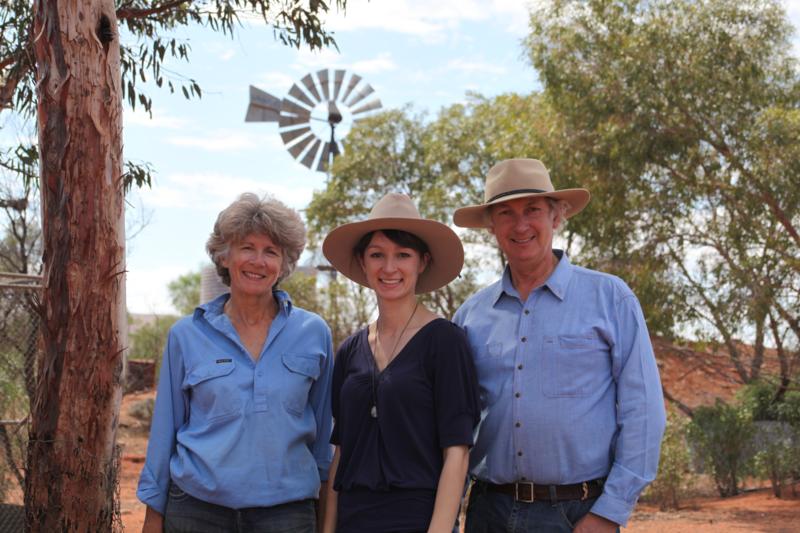 Anika Molesworth with her parents, Lindy and Simon Molesworth at their family property Rupee Station, Broken Hill. Photograph supplied.
Anika Molesworth with her parents, Lindy and Simon Molesworth at their family property Rupee Station, Broken Hill. Photograph supplied.
Their family home runs off the water from the Darling River. “It’s not very pleasant, it smells and it’s got a funny colour but what are we going to do out here – we have to shower in it and wash our clothes in it. We’re lucky we’ve got rainwater to drink, and a bore but it’s very salty,” she adds.
“When you actually see the river you could cry, it is just so sad what has happened. The Broken Hill and Menindee community has rallied against what’s happening, they’re speaking out and showing their strengths.”
“It’s such a complex and challenging issue and there’s so much competition for our scarce water resources,” Anika says.
*Anika helped form Farmers for Climate Action, and connects land managers to researchers through her platform Climate Wise Agriculture to build resilience into farming communities.
“The fact that there’s been an entire collapse of an ecosystem in the Darling River – it’s incredibly distressing and shows that something is not right and has to change.” - Anika Molesworth
Naturally, because of the difficult farming environment, the farmers out here are very adaptive, she says. There’s been a drastic shift in the past 20 years with what people are producing and the numbers of livestock in Western NSW. There used to be a lot of Herefords and Merinos in the district.
Now, she says, “We’re running African sheep and goats and it’s getting tough so what’s next after that? We’re coming to the end of the line in terms of our current adaptive capacity.
Anika says, “I’m upbeat because farmers are such a resilient and determined breed of people and I think that’s why I love working with the farming community so much.”
“But I’m really hoping that we’ll see some high-level leadership in environment and climate – they are too big for farmers to tackle by themselves. Business as usual is no longer possible, we need something to change.”
RELATED TOPICS:
Regenerative drought proofing tool in Western NSW
Biodynamic farming reaps rewards
Sustainable Merino farm turns to perennial grasses
Five-point plan to lift spirits and businesses in Menindee
After the fish kills, the Darling River community is set to receive a wave of government funding, part of the Menindee Regional Tourist Association’s five-point plan to lift spirits and business.
- $25 million to seal the Pooncarie-Menindee road.
- $5 million for a native fish hatchery to help replenish stocks.
- $200,000 tourism promotion package.
- $30,000 for tourist association events and potentially a permanent officer for the visitor centre/national park.
- A mobile phone tower to improve connectivity.
*Additional funding included: $7 million for the construction of the Baaka Cultural Centre at Wilcannia.
A WIN FOR NSW FARMERS
As The Farmer went to press in June, there was some good news on water costs. NSW Farmers’ Western regional services manager Caron Chester says: “We’ve just had a win via our Menindee chair Terry Smith.” Terry wrote to Minister for Water Melinda Pavey and the Independent Pricing and Regulatory Tribunal, which has confirmed it will keep water and sewerage prices flat for most Broken Hill residents and businesses over the next three years.